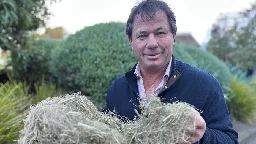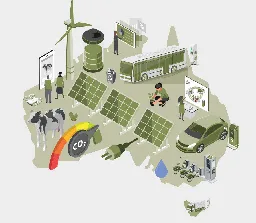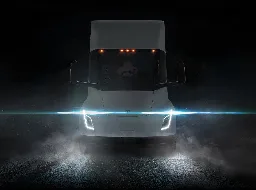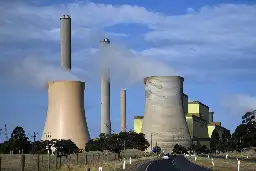Those turbines look interesting, definitely a plausible technology based off that video. Looks like they have used gearing between the two blades to concentrate the energy from both blades so you only need one electric generator (generally just referred to as an electric motor but they do both) which is far more efficient (but still along the same lines of) stacking multiple up using electrical connections like you can do with solar modules to increase power output, which is what I was thinking of when I wrote my previous comment.
It also makes me think of this, https://youtu.be/Qbv_dtwTGDo?si=fSpRWpGqBlTEjMqH, which seems like a decent idea to me.
I'm not sure if it is a lack of feasibility that is getting in the way or just a lack of political will and interest. Could even be because solar is so cheap now that a newer, less refined technology (even in terms of legislation and infrastructure planning) with higher up front costs is just less desirable. I think I could still be worth investing in both in the long run (assuming it is actually viable).
I don't know heaps about them directly, but in terms of rooftop VAWTs I guess it could depend on the type of roof, and ultimately the amount of wind that the rooftop will be exposed to.
It could be more challenging to create residential scales VAWT than it would be for commercial buildings such as the ABC building you mentioned (don't know it off the top of my head but I'm assuming it is a least a few stories tall). I'd say a reason for this could be that as the amount of wind the turbine is exposed to reduces, so would the size of the generator, to ensure the force of the wind on the blades can generate enough counter-torque to get the blades moving and therefore generate power. Using smaller motors would definitely be possible, but you might reach a point where the amount of materials needed for each small-scale VAWT outweighs the amount of return through energy generation of each turbine, because the motor is so small, and counter-torque so small that the motor turning would only generate negligible amounts of power. EDIT: Forgot to add the context of I think there is generally more wind at higher altitudes, whether this is an in general rule or relative to the surrounds (like being in a valley vs being at the highest altitude in the region; or if you are in a low density township vs if you are in a density populated city with more structures blocking wind) I'm not certain, but it is the context for why I said residential rooftop VAWT may end up having far lower generating potential that commercial rooftop VAWT, because I'd say there is more wind on the roof of a commercial building than a residential one.
I would guess the large horizontal axis wind turbines would use large AC induction motors to generate the electricity as the blades turn. I would guess that AC motors would have some size limitations (easier to make really big ones than really small ones, not to say really big ones would present other challenges, but it would be incredibly challenging to make them under a certain size due to all the copper windings that need to fit in the motor) so once your VAWT reaches below a certain size a DC motor would need to be used. This introduces further complications, as our grid runs on AC, any DC power generation first needs to be converted to an AC waveform for the power to be injected in the grid (or used to power a load connected to the grid). This process is already performed for solar using inverters. It would also be performed for HAWTs (probably both AC to DC conversion followed by DC to AC conversion) to ensure the output (voltage, frequency, power factor) matches the grid.
It gets more complicated though, as inverters have an allowable operating DC input voltage range (these can be quite high voltages as you can place solar modules in series to increase the voltage of the generation. For example, if you put two solar modules, each with an operating voltage of 50V (arbitrary number) in series, the total voltage of that series connection will be 100V). This allows larger inverters to be used. It may not be as easy to utilise larger inverters in such a way with VAWT unless you scale up the number of them as using inverters for each individual small-scale VAWT could mean the use of a lot more materials. EDIT 2: There are cases where small inverters (known as micro inverters) are connected to every solar module in an array, so it could be argued you could do the same with small VAWT. There are also things called optimisers, which i think essentially perform the operation of a chopper (described further below) changing the DC voltage to match all the other modules before connecting to an inverter. Both of these option involve extra costs when compared to direct connection of entire strings (described further below) of modules to an inverter.
Considering using VAWT with batteries will also have added complications. Batteries store DC energy, so an AC to DC conversion would not be necessary to charge the batteries, but you would most likely still need DC to DC conversion (from memory they are called boost/buck choppers) to increase or decrease the input voltage to match the battery terminal voltage (a lot of solar inverters that can connect to batteries most likely already have these installed internally). These boost/buck choppers also have voltage input limitations, meaning they won't operate if the input voltage is too low or too high. Therefore, to be able to use both solar and wind on say a residential rooftop, it may mean the installation of more, or retrofit of existing electronics so the power waveforms of both the solar modules and the VAWT can be transformed to match the grid or battery power waveforms. I think it's probably unlikely that a smaller VAWT could match the voltage of multiple solar modules connected in series (known as a string), so either a second chopper would need to be added which can transform DC waveforms from a much lower voltage to match the battery terminal DC voltage (vs comparing the voltage difference between the solar string choppers input/output voltages), the choppers in the inverters would need to accept a far greater input voltage range, or as I said above, you would need to connect multiple small-scale VAWTs together to develop the necessary power waveform.
This may be one of those things where if we started designing/building/installing small-scale VAWTs about a decade ago there may have been more incentives for inverter and battery manufacturers to enable VAWT connections through the same hardware, or could be something we could consider if Aus goes down the inverter/battery manufacturing path in the future.
It could also be possible that people in the relevant technical positions have already considered all of the trade off's and they just don't add up to make small-scale VAWTs viable. This could be why we rarely hear about them. These things can always be subject to change though as technologies and manufacturing processes improve and change, and materials costs reduce.
Pervoskite still has some challenges to overcome before it can be a primary material in solar modules. One of the major problems being Potential Induced Degradation (PID) which is ironically caused by sun exposure, and leads to decreased power output from the solar cell. https://www.sciencedirect.com/science/article/pii/S2666386422003174
The market is currently looking transitioning from p-type modules to n-type (both crystalline silicon based). P-type was the market leading technology for many years because issues like PID, Light Induced Degradation (LID) and Light and Temperature Induced Degradation (LeTID) were more easily resolved in p-type modules. N-types (also known as TopCon) are taking over now as these issues are being resolved and n-types are capable of reaching higher efficiencies than p-types. The higher power classes of n-types (>= 430W) over p-types (peaked around 415-420W) [these power classes are from modules designed for residential installations so have a surface area of about 1750mm*1100mm] is also enabling people to claim the maximum rebate for installing solar on their residence. This is because there is a rebate maximum that is based on installations up to a total size, and the newly released n-type modules (have only been in the market a little over a year) have a power class (440W) that divides evenly into the max installation size (6.6kW) so people can claim the entire rebate.
It looks like the manufacturers are looking to work towards developing hetero-junction (HJT) solar cells. There are a combination of both silicon and pervoskite, with the intent to be to make the most of both materials properties to improve module efficiency while also keeping PID, LID and LeTID within reasonable levels across the module's lifetime.
Edit: just adding some more citations. I haven't directly quoted from any of the sources, just regurgitated info from my head and added them for further readings. Information above may be subject to some inaccuracy. https://www.solarquotes.com.au/blog/p-type-and-n-type-solar-cells-excellent-electron-adventure/
https://www.maysunsolar.com/blog-n-type-solar-cell-technology-the-difference-between-topcon-and-hjt/
https://www.nrel.gov/docs/fy21osti/78629.pdf
https://www.pv-magazine.com/2019/03/12/lid-and-letid-qa-with-jinkosolar/
Edit 2: grammar/spelling
I've been considering calling the platform FascX. Not sure how well it works though.
Hemp is one of the toughest plants on the planet and its potential uses range from bulletproof vests in the US to waterproof flooring for housing and other robust building products in Australia.

Brett Boag holds a small square of what appears to be ordinary wooden, 20-millimetre-thick chipboard.
Only this material is heavier and startlingly stronger.
Bulletproof in fact.
During a recent test in the United States, it withstood even a burst from a high-powered AK-47.
"It's phenomenally tough. We're making products that are even way in excess of the hardest hardwoods, very high impact resistance as well," said Mr Boag, who manufactures construction materials at a factory east of Melbourne.
The products are made from hemp — one of the toughest plants on the planet. ...
Considering
Only 1% of Australian taxpayers own nearly a quarter of all property investments across the country, amid concerns over escalating rates of wealth concentration.
Data provided by the Australian Taxation Office has revealed the extent of that concentration, with more than 7% of property investors – or 215,321 people – accounting for 25% of all property investments.
That 7% also have three or more interests in investment properties across the country, with 1% of investors – or just 19,895 people – currently holding six or more investment interests.
And that is only the top 1% of tax payers (which is only 7% of investors), I can't imagine what percentage of property investment is owned by the top 10% of tax payers.
No doubt, but steel production produces a lot of pollution as well. It will be interesting to see the progression of green steel manufacturing tech and battery tech vs one another over time, even hydrogen tech. Its a tough choice because at any point we could see a major breakthrough in one of them making all the others relatively less cost and environmentally sound options.
So I've been reading up on this topic a bit more and I came across this
Problem Australia’s interstate freight rail network comprises many long sections of single track. This restricts the number of train paths, reducing rail’s competitiveness with road, and hindering rail’s ability to meet growing freight movement demand. The interstate freight rail network needs to be enhanced to accommodate growth in the freight and passenger task, and improve efficiency and safety.
On the bright side it is a proposal to upgrade a lot of the rail corridors to support more freight than we have currently. Though it was added in 2016 and is still only in the 'potential investment options' phase
Yeah true I didn't even think about batteries or hydrogen as diesel replacements for trains. The up to 6MWh of storage your article quotes for the short distance hauls sounds like a lot of storage, but I guess there is a considerable amount of surface area at the bottom of a locomotive that could be filled with batteries, and if each locomotive can't hold enough storage to pull the load, you can just add another locomotive to the train to make up the difference.
Unfortunately we don't have a rail freight network that either works well or reaches every township in Australia, and until we do encouraging the switch from ICE road haulage to EV road haulage is the best way to reduce transport industry emissions.
For a lot of the more rural towns (or a least for the ones I know of) that do have rail connections, they are only accessible using diesel locomotives as there is no electricity network set up to power electric trains. So if we don't want to introduce more emissions from rail freight we would have to electrify the whole rail network.
Realistically we should be building rail and allowing EV trucks to be more accessible, but Australia is a big place, building all that rail infrastructure will take time. A good stepping stone would be to build rail connections to regional urban centres and then have trucks distributing it to the surrounding towns, but even building that much rail will take time. And that's just the construction. The amount of time it would take to secure the land corridors for the rail would be considerable alone. AEMO have been having a difficult enough time securing land rights to build transmissions networks across properties
Australian Academy of Technological Sciences and Engineering joins calls for government to be more ambitious with its energy targets – net zero by 2035.

The Australian Academy of Technological Sciences and Engineering (ATSE) has released a statement urging the government to be more ambitious with its energy targets – net zero greenhouse gas emissions by 2035.
This is just one day after the Climate Council called on the government to do the same.
“The science is unequivocal, the climate induced catastrophes are irrefutable. ATSE calls for leaders across every Australian sector to join us in making Australia a frontrunner amongst global peers, in setting an ambitious target of net zero greenhouse gas emissions by 2035,” said ATSE President Dr Katherine Woodthorpe.
“To meet this ambition, with the Federal Government in the driver’s seat, Australia should prioritise upskilling our workforce, and develop and urgently apply evidence-based solutions across all industry sectors – particularly in energy, transportation, manufacturing, construction, minerals and agriculture.”
The position statement highlighted six top priorities. They included developing new policy for the energy network, limiting waste, and increasing the electrification of the transport industry.
“We’re the engineers and the applied scientists, we’re the ones where the rubber hits the road – who work out how to do this,” Woodthorpe told RenewEconomy.
“And we’re saying it’s doable. It’s not easy. It’s a huge task, but it’ll set Australia’s economy up for the future in a world where climate will be a real issue.”
Decision to allow wider trucks on Australian roads should pave the way for the electrification of heavy duty transport.

A major change to Australian design rules promises to be a “game changer” for Australia’s shift to electric freight transport.
The new rule announced by the federal government will allow wider trucks on Australian roads, bringing the country in line with overseas markets and removing one of the key barriers to local uptake of heavy duty electric trucks, as most overseas-built models were just a few centimetres too wide to meet Australia’s previous standards.
“This Safer Freight Vehicles package responds to direct calls from industry to increase the width limit of trucks and follows extensive public consultation and feedback,” said federal assistant minister for infrastructure and transport Carol Brown.
“These changes will be a real game changer for industry, businesses and other road users, as they will save lives by adopting technology to reduce the likelihood of crashes, while also lowering freight costs and supporting better environmental outcomes.”
The change increases the overall width limit from 2.50 to 2.55 metres for new trucks, as long as they are fitted with safety features such as side guards and devices to limit blind spots.
This actually seems pretty positive, but I guess also demonstrates how responsible Howard is for helping set in motion Australia's apathy towards environmental destruction, especially when it gets in the way of fossil fuel operations.
Possibly, but Turnbull did take over as head of https://murdochroyalcommission.org.au/ after K Rudd stepped down to take whatever diplomatic job it was he took.
I think the Murdoch press had a big hand in Turnbull being replaced as PM, because he was actually considering implementing renewable energy policies https://www.theguardian.com/australia-news/2018/sep/19/turnbull-warned-rupert-murdoch-trying-remove-him-prime-minister
That same day the Daily Telegraph had warned of “a toxic brawl” over energy policy. On Sky the night-time commentators Peta Credlin and Andrew Bolt ramped up their negative assessments of the national energy guarantee and of Turnbull himself.
So he is probably butthurt for other reasons too
Former Australian prime minister’s nomination revealed a day after Rupert Murdoch retired as chair of Fox and News Corp

Former Australian prime minister’s nomination revealed a day after Rupert Murdoch retired as chair of Fox and News Corp
The abuse isn't the only issue either, it seems like some of the carbon credit organisations aren't fulfilling their claims either https://youtu.be/Vw3jw5IYL2c?si=R75QkDgFQV_S6o06
Labor bins hundreds of millions of Kyoto “carryover” carbon credits, permanently removing the option to use them to shirk Australia’s climate responsibilities.

Federal Labor has binned hundreds of millions of Kyoto “carryover” carbon credits, permanently removing the option for them to be used in to shrink Australia’s emissions reduction task and shirk its climate responsibilities.
Federal energy and climate minister Cris Bowen announced the move on Friday, day two of the 10th Australasian Emissions Reduction Summit in Sydney, and confirmed it in person at the event.
“My colleague, assistant minister Jenny McAllister, has signed the instruction which cancels them, they’re gone,” he told the summit on Friday morning.
Australia’s surplus Kyoto credits, which had amassed to more than 700 million, have for years been a blight on Australia’s climate efforts, even when those efforts themselves amounted to the better part of nothing at all.
In 2019, the Morrison Coalition government had sought to use the credits, created under the Kyoto Protocol through soft targets and convenient accounting loopholes, to further minimise its already paltry climate mitigation efforts.
Labor says non-payment of super should be in the same category as wage theft, but the ATO has never used existing criminal powers

Labor says non-payment of super should be in the same category as wage theft, but [they have not included it as a criminal offence in their industrial relations bill and] the ATO has never used existing criminal powers [as far as I could tell from the article the only powers the ATO has is fines, and fines mean next to nothing when a business has already declared bankruptcy]
It would be interesting to know if returns were taken into account as well. I know these days certain brands will not only delivery the clothes you purchased to you, they will come and collect the clothes you decide you don't like. These clothes are sometimes repurposed but often just thrown out as well. The below article discussed this. I can remember seeing an article more specific to Aus a while back but this is the best I can find for now.
Edit: spelling and grammar
Bamboo is fine to machine wash as far as I know. At least I have always used the washing machine for it and all my stuff is fine.
To an extent I agree about your perspective on weeds themselves, the only thing I would argue is some plants are pretty invasive and can kill off others, so they are worth removing or at least keeping in check.
I cant say for certain, but I can definitely speculate. I do know cotton requires a fair amount of water to grow, but I don't think it would use as many petrochemicals in the production. Though it would still use some, even if that is just in the supply chain through things like diesel for trucks and ships. The chemicals they use (like pesticides) may be derived from petrochemicals, but even if they aren't they could be damaging to the environment in many other ways. So I think polyester could have the greatest emissions of the two.
I guess it could depend on the scale of production too. Like if we were to try and replace all polyester clothing with cotton, that could have a massive impact due to the amount of land and water needed to produce such quantities of cotton clothing and such. But at the same time, creating clothes out of plastic isn't going so well either.
Ultimately we will probably still have to have some diversity materials for sustainable clothing production. It will really come down to a balance of land use, water use, what uses the least amount of chemicals, and probably a lot of other considerations.
I think bamboo is a good up and coming fabric. Bamboo grows like a weed so it's pretty sustainable and I'd say it's pretty durable as well. I've got some bamboo work socks a couple of years ago and they are still going hard. Super soft and comfortable too.
I don't think there are heaps of options available in terms of shirts and shorts, pants, etc yet. I'd say the ones that are out there would be more expensive than polyester or even cotton. But hopefully as the industry grows they get cheaper.
Edit: I think bamboo breathes really well too. Well it at least seems to with those socks I have. So it could be a good fabric for hot weather too.
Many of us are now dressed head to toe in plastic thanks to the invention of cheap and durable textiles like polyester. But the extent of the environmental impact from these garments might surprise you — we've tracked the life cycle of a polyester top from an oil field, through to when you chuc...
Many of us are now dressed head to toe in plastic.
A textile derived from the same non-renewable source as takeaway containers, has grown to make up more than half of the clothes bought in Australia.
Polyester is durable, cheap, and dries quickly. It’s also easy to print patterns on.
It’s commonly used by itself or as a blend with other textiles. It’s used for gym clothes and sports uniforms, party dresses, work attire, and many cheap fast fashion items.
And every purchase is taking an environmental toll.
One Australian study by RMIT found a single 100 per cent polyester T-shirt has a carbon footprint — from creation through to when you dump it in the bin — equivalent to 20.56 kilograms of CO2 emissions (CO2e).
That’s equivalent to driving 140 kilometres. Buy just six tops, and that gets you all the way from Melbourne to Sydney.
So, what’s involved in getting a T-shirt from a fossil fuel, to the one you might be wearing right now? Here’s its journey along the supply chain.
Former Liberal MP, who is undertaking a six-month ultramarathon around Australia in support of the referendum, says he’s ‘incredibly disappointed this has become a political issue’

Former Liberal MP, who is undertaking a six-month ultramarathon around Australia in support of the referendum, says he’s ‘incredibly disappointed this has become a political issue’ ‐‐------------- The article is full of some really good quotes, including > “I’ve come across communities drinking bore water all their lives and then they need dialysis at an early age, kidney failure, when all they need is a filtration system on their water, but nobody’s listening – instead government is dishing out buildings for them they don’t need,” he says > “These people have been neglected for such a long period of time. Everything we have in place just isn’t working. It’s not addressing the early mortality rate, more Indigenous people in the prison system, health and infrastructure needs. It makes sense that we need a different approach.” > “I’ve heard things said by politicians that they want more detail – that’s just a lie, they know they create the detail, as part of the processes the Australian people will vote on,” he says. “Then it’s up to the politicians to nut that out in the parliament, what the detail is and then vote on it and get good policy in place. I’ve said to Coalition members, ‘Why not let the Australian people decide, then you can argue to the nth degree when it gets to the parliament’ – but they’re just being antagonistic.”
Some compelling insight. Mad props to this guys!
Is this the great Factorio Square spitter massarcre?
